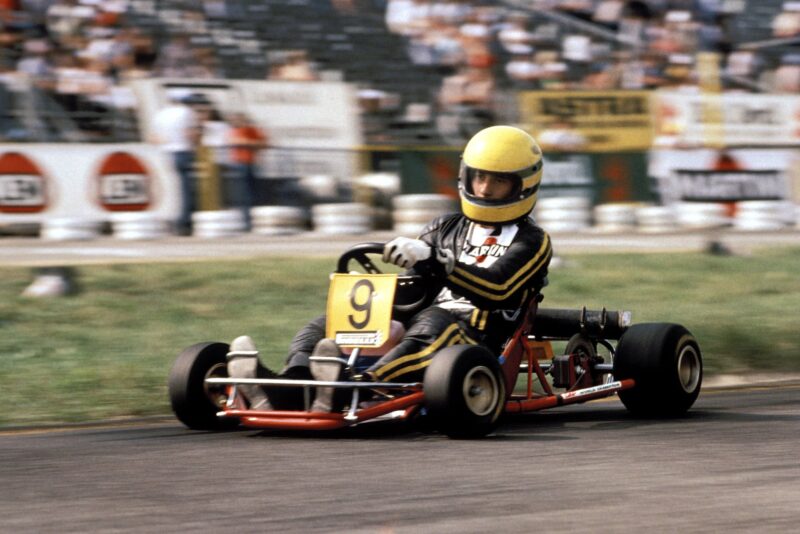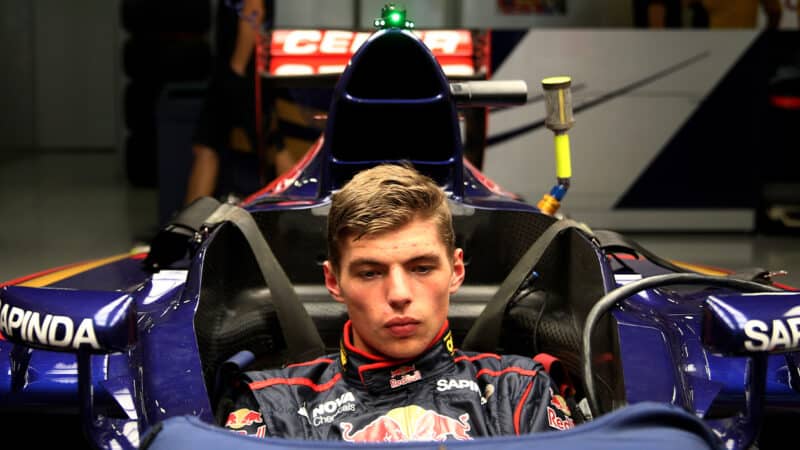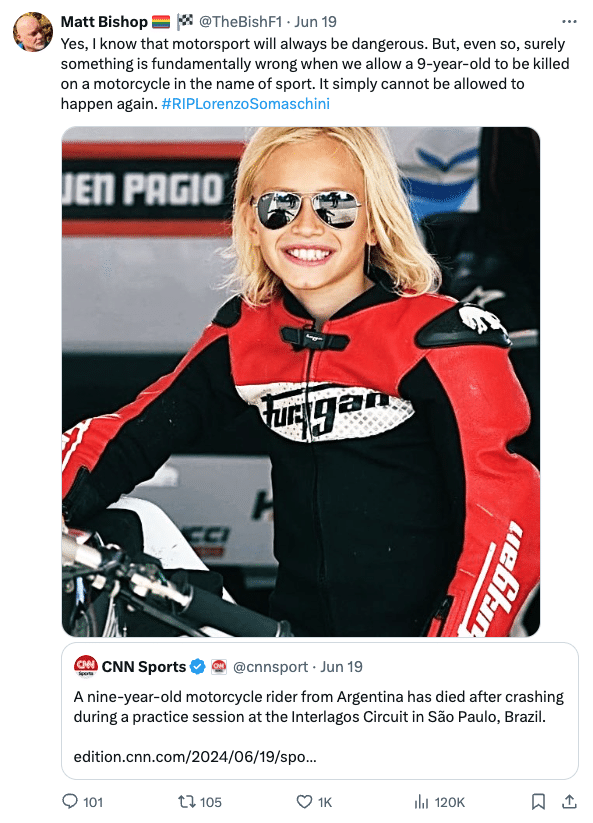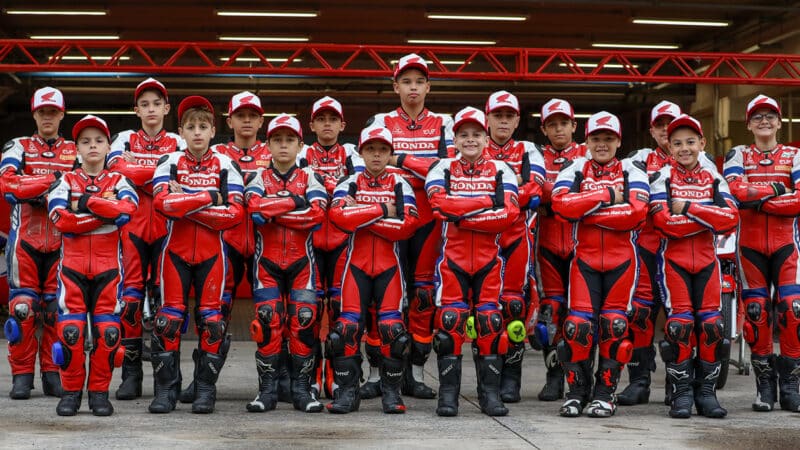And perhaps for competitive kart racing, too? Like motorcycle racing, kart racing is also less safe than the the kinds of sports that children routinely play, albeit not as dangerous as motorcycle racing. However, increasingly, karting is becoming ever more youth-oriented. In 1974, 50 years ago therefore, there were 4028 licensed karters in the UK, 3537 of them (ie, 88 per cent) seniors. And now? The senior/junior split is not recorded these days, so I will put it this way: the Association of British Kart Clubs reported in its recent annual general meeting that more than 70% of new Association of Racing Karts Schools tests were for juniors. That shift constitutes a demographic upheaval. A 60-something mate of mine who used to race karts recently sent me the following WhatsApp message: “Karting is being kidified.”
In 1980, at Jesolo, near Venice, Italy, Terry Fullerton overtook Ayrton Senna on the last lap of the Karting World Championship Final to win the Champions Cup. Senna was 20, Fullerton 27. After winning the 1993 Australian Grand Prix, his 41st and last F1 grand prix victory, Senna was asked in the post-race FIA press conference to name the driver whom he had most enjoyed racing. He thought long and hard, then spoke not of Alain Prost or Nelson Piquet or Nigel Mansell but instead said: “Fullerton. Terry Fullerton. He was very experienced, and I enjoyed very much driving with him because he was fast, he was consistent. He was, for me, a very complete driver. I have that as a very good memory.”

Senna still karting in the 1981 World Championship
DPPI
It would be inconceivable now that a driver who would end up winning three F1 drivers’ world championships, as Senna did, could still be karting at 20. Equally, there are now far fewer Fullertons — serious adult karters — than there were then. Senna was 21 when he began racing cars (Formula Ford 1600). He was 22 when he moved up to Formula Ford 2000. He was 23 when he made his Formula 3 debut, winning the British F3 Championship, beating his fierce rival Martin Brundle, who was 24. Nowadays, drivers who are still racing in F3 in their 20s are reckoned to have missed the F1 boat.
A cult of youth got a hold of driver selection where rookies were concerned. It is not necessarily a good thing
But how can that be logical, when Ferrari is prepared to hire a man who will be 40 when he makes his debut for the Scuderia next year, and when the Aston Martin F1 team’s number-one driver will turn 43 next month? Do not misunderstand me. I am not dissing either Ferrari or Aston Martin. Equally, Lewis Hamilton and Fernando Alonso remain fit and fast, both of them still among the very best drivers in F1. Why, therefore, should excellent F3 and even F2 drivers 20 years their junior be written off as too old? It makes no sense.
For example, Ollie Bearman was 18 when he raced for Ferrari in the Saudi Arabian Grand Prix three months ago, and he will drive for Haas in F1 next year. Bearman is a good driver, but Théo Pourchaire, Frederik Vesti, Jack Doohan, Ayumu Iwasa, and Victor Martins all beat him in last year’s F2 championship, yet none of them has bagged a 2025 F1 drive, and all of them are in their 20s. Senna was 24 when he made his F1 debut, as was Prost. Piquet was 25 when he drove his first F1 grand prix. Mansell was 27 when he broke his F1 duck. No-one thought those four F1 rookies too old, and they were right not to do so, for they were not, and they all went on to win a ton of F1 grands prix and world championships.

Max Verstappen was 17 when he first competed in F1 for Toro Rosso
Max Verstappen’s impact on F1 has been and remains enormous. But perhaps the biggest change that he has wrought on top-tier motor sport has been as much a result of his fast-track arrival as of his undoubtedly colossal ability. When, in Melbourne in 2015, that oh-so-precocious Dutch 17-year-old made his F1 debut then began to assemble a magnum opus of quick-fire success more rapidly than anyone had ever done before, he revolutionised the world of single-seater racing. Overnight, a cult of youth got a hold of driver selection where rookies were concerned, and its grip remains vicelike still. It is not necessarily a good thing.
As I say, my aim in writing this column is to ask a question, to which I hope wiser and more influential folk than I will bend their minds. To repeat, my question is: do you think that the age of consent for competitive motorcycle racing should be higher than it is now? I will add: do you think that the age of consent for competitive kart racing should be higher than it is now? Please have a think about both questions, bearing in mind the booming popularity, growing reputability, and increasing realism and authenticity of modern sim racing, which is a 100% safe alternative to circuit racing and is being embraced enthusiastically by racers in the very age group about which it is clear that I am becoming ever more concerned. And, finally, if your answers to both my questions are “no”, for both competitive motorcycle racing and competitive kart racing, please have a think about how you would reply to the broken-hearted mother of a nine-year-old boy who had been killed in a motorcycle racing or kart racing accident, if she were to ask you: “Do you think my nine-year-old son had the emotional maturity to understand his situation fully, and thereby to give the informed consent required to take on the mortal danger to which he was being exposed?”
May perpetual light shine upon poor Lorenzo Somaschini, and may he rest in peace.




